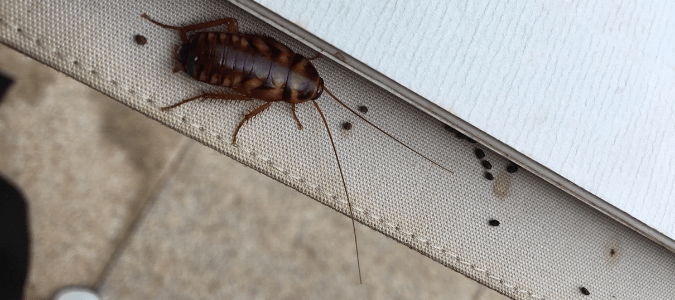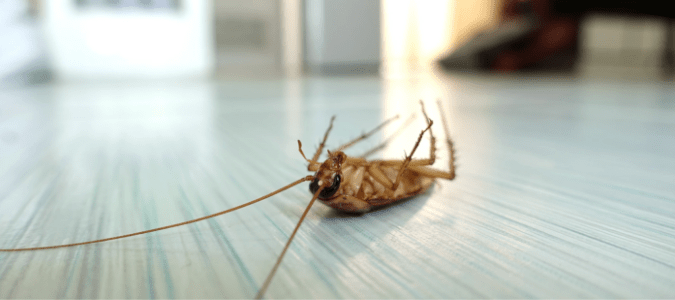“I found a roach in my house. Should I be worried?” This is a common question that customers often ask pest control professionals. If you find a single cockroach in your home, does it mean there are more? Could you have a cockroach infestation? And whether it’s just one roach or a whole nest of them, what should you do about it?
The simple answer is, if you find a roach in your house, there is definitely reason to worry there might be other roaches hidden nearby. It’s possible there is even a full-blown infestation. It largely depends on what type of roach you’ve found.
Certain kinds of cockroaches, like American cockroaches, can make their way inside people’s homes almost by accident. American cockroaches are the big ones—well over an inch long, a half-inch wide, and medium reddish-brown in color. These roaches normally live outside. They sneak in through gaps around doors, windows, vents or hose bibs. They might get in by crawling along water pipes under the house.
Seeing an American cockroach indoors may or may not be cause for concern. These roaches can infest a home if they find enough of what they need inside to thrive. Namely, they need what most pests do: access to food and water, and a good spot to build a nest. But American cockroaches prefer to nest and reproduce outdoors. Spotting one in your home may just be an isolated incident.
Finding a German cockroach indoors, on the other hand, is usually a sign of an infestation. German cockroaches are the small ones—about a half-inch long and a quarter-inch wide, with bodies that are tan or medium or dark brown in color. These roaches live only indoors. They typically get inside houses when people bring them in without realizing.
Hidden egg cases or even baby roaches can hitch rides inside on paper bags or cardboard boxes from the grocery store. They can also be hidden within second-hand items purchased at a yard sale or thrift shop. There are many ways for German roaches to get inside your home. However they get in, they are well adapted to living indoors.
These roaches also reproduce incredibly fast. Before they hatch, roach eggs are encased inside small, brown, hard-shelled capsules called oothecae. A German roach ootheca can hold between 20 and 40 eggs, and a female German roach can lay four or five oothecae in her lifetime. That means she can produce hundreds of baby roaches over time.
The eggs take about four weeks to hatch. Once they hatch into nymphs, they will molt several times before finally becoming adult roaches. This process takes several months. After the final molt, the new adult roaches are ready to reproduce. This is how a single cockroach case, accidentally brought into your home, can spur an infestation. Within very little time, your home can be overrun by these unsanitary pests.
Another problem with roaches is that it can take a while to realize you have an infestation. Cockroaches are mostly active at night. If you head to the kitchen for a late-night snack and flip on the lights, any roaches will scatter to the nearest hiding place. They move fast, and their bodies are nearly flat. This makes them very good at hiding quickly. You may not see roaches often, even with an active infestation going on inside your home.
There are other signs of an infestation besides roaches themselves, though. Here are some things you might notice if you have a roach infestation in your home:
- Roaches, whether alive or dead. You’re most likely to see them in the kitchen or the bathroom—places where they can access food or water.
- Oothecae—the small, hard, brown, banded cases that hold roach eggs before they hatch into nymphs. These might be found anywhere, but roaches usually lay their egg cases in protected spots. Look in crevices and corners, and underneath cabinet overhangs.
- Roach feces and smears. Their droppings are tiny, dark brown pellets that look somewhat like coffee grounds. Their smears are also dark brown; they might be little dots or streaks. You might see them on walls or baseboards, inside cabinets, or anyplace where roaches spend time.
- Chewing damage to books, cardboard boxes, paper bags, or food packaging inside the pantry. Cockroaches can feed on a variety of different things. They can even eat paper and the glue that binds books together. They can also chew through fabric as well as food packaging.
Keeping your kitchen clean is a very important part of keeping roaches at bay. Wipe up crumbs and spills, and wipe down the stovetop after cooking. Keep food in airtight containers that pests can’t chew their way through. This goes for pet food as well. Similarly, limit roaches’ access to water by emptying pet water bowls at night. Fix any leaky faucets or pipes, so roaches won’t be drawn to them.
Clearing away clutter is another important part of keeping roaches away. Storing things in cardboard boxes or keeping piles of magazines around can draw roaches. Getting rid of these items will cut down on places roaches can hide as well as things they can feed on.
Unfortunately, even the cleanest homes can have cockroach infestations. And cockroaches are known disease carriers. They contaminate food and surfaces that they touch. They can also cause allergies and even asthma in people who are susceptible.
If you think you might have a roach problem, it’s time to reach out to a pest control specialist. A pro can inspect your home and determine which type of roach you’re dealing with. They can find the roaches’ nest and develop a customized plan to get rid of the pests.
Roach Lifespan and Life Cycle
German cockroaches have a lifespan of about nine or ten months total, from egg to nymph and all the way through adulthood. American cockroaches, on the other hand, can live for several years in the right conditions. But even if a typical roach lifespan is just a few months, these pests reproduce incredibly fast. This is how they can quickly infest a home.
It takes German roach eggs about a month to hatch into nymphs. The nymphs will molt six or seven times over the course of several months before finally maturing into full-grown adult roaches. The adult phase of the German roach life cycle lasts about six months. During that time, an adult female can produce around 200 baby roaches.
American cockroach eggs take about four to six weeks to hatch into nymphs. Then, they molt ten or more times before becoming fully adult roaches. This process takes well over a year. At that point, the adult American cockroach can live another year or two, reproducing the entire time. A female American cockroach can produce well over 200 baby roaches in her lifetime.
There are lots of factors that can affect how long roaches live, of course. A roach living indoors, where the temperature is comfortable throughout the year, may live longer than one living outside that is exposed to intense heat in summer or cold in winter. Indoor roaches may also live longer because they have steady access to a reliable food supply.
Roaches are incredibly hardy, however. They can survive being submerged underwater for more than half an hour. They need water to live, yet they can go without drinking any for a week. Even more impressive, they can live without food for a whole month! And, they can even live without their heads for an entire week. Their natural hardiness along with their ability to reproduce quickly can make them very hard to get rid of. Enlisting professional help in the battle against these pests is often the most efficient way to get rid of them. This is especially true if your home has a serious pest infestation.
What Repels Roaches?
If you have a cockroach problem, you’re probably wondering what repels roaches. Is there anything you could do or any product you could use to make your home less attractive to these pests? Roaches do supposedly dislike sharp or spicy scents like vinegar, bleach, peppermint, garlic and citronella.
You can also repel roaches with borax or diatomaceous earth. Both of these products are not toxic for people or pets, as long as they don’t come into direct, close contact with them. When roaches ingest borax, they die because of dehydration. Diatomaceous earth destroys their exoskeletons. If you know where roaches tend to congregate in your home, you can spread a light dusting of either of these products to kill them off.
Just be careful not to use too much of either product, or to spread them in places where you, your family or your pets might encounter them. The same also goes for more toxic roach pesticide products, too. Any roach killer product should be used carefully, according to the directions on the package.
It’s also wise to be aware that many people who try controlling a roach infestation with natural approaches find they only prolong the problem. A reputable pest control professional has the most up-to-date training, products and techniques for getting rid of roaches. This makes them the best bet for dealing with an infestation. They can set up follow-up visits to inspect and re-treat as needed, so the pests don’t return. They can also give you tips tailored to your home and family to keep roaches away for the long term.
ABC Can Get Your Roach Problem Under Control
We understand how disheartening it can be when you can’t seem to get rid of roaches. ABC Home & Commercial Services can help. We will create a comprehensive cockroach control plan, so you can feel more at ease at home.



